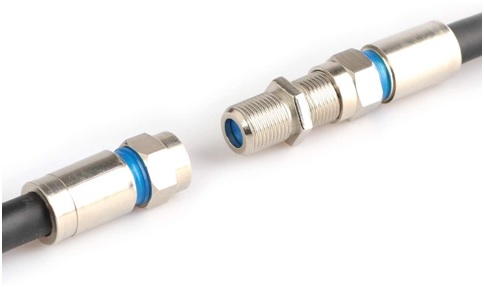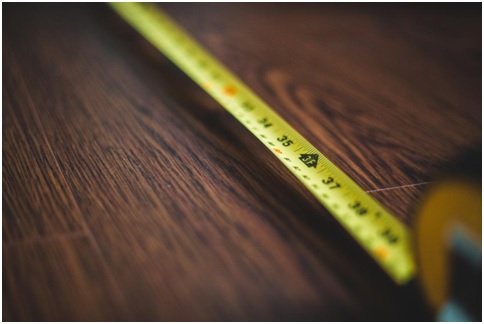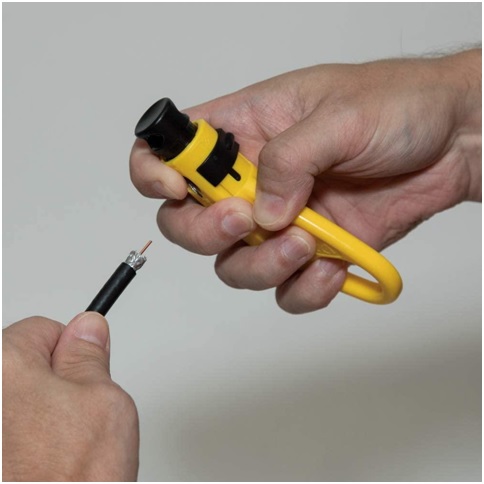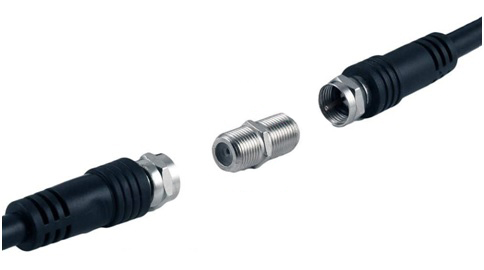
*As an Amazon Associate we may earn from qualifying purchases when you buy through links on our site.
A coaxial cable is a type of cable (usually white) running down from your TV antenna to your television. It’s also used by the cable company to bring you cable TV and internet.
There may be situations when you’ll want to extend a coaxial cable rather than just replace it with a longer one. For instance, if you move your TV set further away from where your outdoor antenna’s cable comes out of the wall.
You extend a coaxial cable by joining a new cable of appropriate length to your old cable, using a so-called barrel connector (otherwise known as a threaded F-type extension adapter).
Some also refer to this process as “splicing” since the process involves cutting away the cables’ outer sheathes to join their cores and surrounding parts via the barrel connector.
Read on to understand the process and know what tools you’re going to need.
What You’ll Need
Here are some parts and tools you’ll need to extend your coaxial cable:
- Extra coaxial cable: Simply be aware you should be matching coax of the same type. The new cable’s type should match that of the old cable’s. RG 6 and RG 59 have differing diameters. Coaxial cable also typically terminates in a male F-connector (metallic), which you’ll connect to the extension adapter / barrel connector (below)
- Coaxial cable threaded F-type extension adapter: Also known as a “barrel connector,” this is the piece needed to easily (i.e., without impedance issues) connect two coax cables together. A typical extender is the GE RG6 Coaxial Cable Extension Adapter
- Coaxial cable compression fittings: These are metal fittings that “cap” a coaxial cable, allowing you to plug it in to device connectors. Here are examples of compression fittings
- A cable stripper for removing the outer sheath of a cable
- A cable compression tool, for placing the compression fittings on the end of each coaxial cable before you join them with the F-type extension adapter (“barrel connector”)
- A tape measure: For measuring the length of the proposed extension
- A multimeter: To check for hot wires (optional)
How to Splice Coaxial Cable
The video below gives a short tutorial on how to extend a coaxial cable.
Step 1: Think About Safety
Before you embark on your DIY project, ensure that the coaxial cable you want to extend is disconnected from all electrical devices. You can also use a multimeter to check if there are any hot wires around before you start working.
An electrical mishap is the last thing you want to deal with when it could have been avoided altogether.
Once all potential safety hazards have been dealt with, proceed with the next step.
Step 2: Measure the Distance
Next, you’ll need to measure the length of the area you intend to extend your coaxial TV cable to. Your measurements need to be as accurate as possible. Just to be on the safe side, shoot for a slightly higher number.
It’s always better to have a longer cable than a shorter one since you can always cut it to the desired length.

If it ends up being too short, you might have to get yet another cable and extender to get it to the required length.
While this shouldn’t be a problem per se, having too many extenders along the same cable line may cause signal loss and be a factor affecting the quality of the signal transmitted.
So it’s always better to keep them to an absolute minimum.
Step 3: Get Your Cables Ready
The next phase involves preparing your cables for the extension process. To begin, use a stripping tool to remove the outer sheaths of both cables, then use the compression tool to firmly place an F-connector on each cable.
Note that you could use a knife for stripping the cables but it would be more challenging to cut both cable ends down to similar dimensions, than by using a stripping tool.
Check that these F-connectors are tightly placed on the cables. You can use your fingers or a pair of pliers to twist the connectors to secure them.

Step 4: Join Both Cables Together
Now that you’ve prepped your cables, you’re ready to join them.
Connect the extension adapter to the end of the TV cable that you’re planning on extending. Make sure that you have a tight connection (especially if it’s outdoors – you certainly don’t want moisture leaking in between the cables).

Then attach the second coaxial cable connector to the other end of the extender.
Step 5: Connect the Destination
Attach the end of the new cable to the TV and attach the other end of the original cable’s connector to the signal source like your antenna (if you had disconnected it before).
Ensure that all connections are firm and secure. Power-up your TV, run a channel scan, and check to see that you can view all the channels with the expected audio and video quality.
If you can’t, troubleshoot the connections to identify any possible mismatches in the connectors and their respective ports.
Choosing the Best Coaxial Cable Extender
Here are a few things to keep in mind when choosing a barrel connector for your coaxial cable.
Affordability
A good coaxial cable extension adapter shouldn’t cost you an arm and a leg. A pack of two to five pieces will typically set you back $5 to $6 on average.
Compatibility
Ensure that you get an extender that is compatible with most (if not all) brands of RG 59 and RG 6 coaxial cables.
That way, you can use it to extend TV, cable box, satellite receiver, off-air HDTV antenna, or any other digital A/V component cable.
Connectors
For the signal to be transmitted at maximum frequency, it’s always better to get extenders that have gold- or nickel-plated brass connectors.
This protects them against corrosion, effectively preventing oxidation of the cable’s center conductor.
Weatherproofing
If you intend to install the barrel connector outdoors, ensure that it comes with a rubber sheath protector to guard against the weather.
Also, make sure that the fittings are tight enough to prevent moisture from getting into the cable.
Ease of Installation
You want a coaxial cable extender that is easy to install and disassemble. Pick one that allows you to screw it on or off both sides of your coax cable.
Conclusion
Use the steps outlined in this guide to extend your coaxial cable by any length and to any other rooms in your home without having to buy a new one each time.
